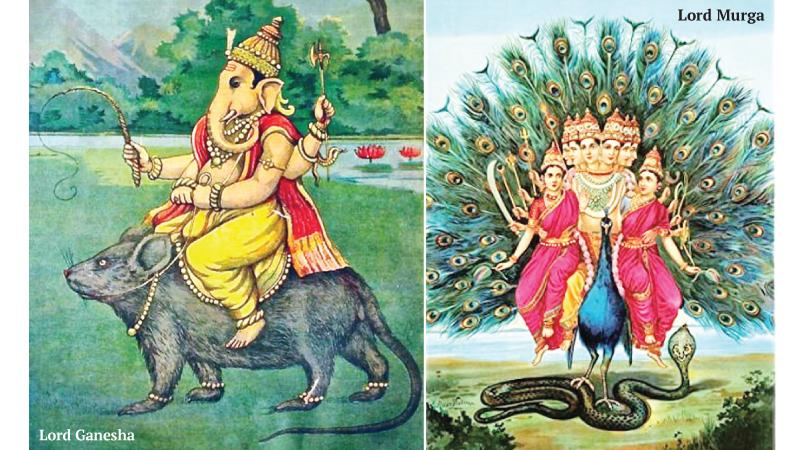
Bharatha Natyam is deeply rooted in Hinduism. Basically, there are two different varieties of hand gestures available in this great art. One is single-hand gestures and the other is double-hand gestures. There are altogether 28 to 31 single-hand gestures and 23 double-hand gestures. Through different hand gestures, numerous symbols of animals, trees, Gods, fruits, leaves, and Vahanams (vehicles of different Gods) are beautifully depicted in Bharatha Natyam to the needs and necessity of the Abhinaya.
This is the only Indian dance form with elaborate categories of different hand gestures for different Gods, leaves, fruits and trees.
While performing Bharatha Natyam the performing artiste according to her own imagination imbibes the categorized hand gestures to portray the appropriate scene or theme.
The Hindu religion is generally known as Hinduism. In Hinduism there are numerous Gods for different purposes. Each God is associated with a bird or animal. The association with a bird or animal is called Vahanam. The term Vahanam means the sacred vehicle of the concerned God. The presiding deity of each temple gives a special place for the Vahanam or vehicle related to that particular God. Lord Shiva’s sacred Vahanam is the bull which is often referred to as Rishapam or Nanthi Vahanam. That’s why Lord Shiva is often referred to as Rishaparudar.
To depict Lord Shiva appropriate hand gestures should be adopted. Similarly, to portray different Gods Vahana gestures are adopted to emphasize the selected theme of the song. Hence, mere learning Bharatha Natyam will not help a dancer to establish anyone in the dance field without knowing Hinduism. Hindu religious knowledge is very much needed for a dancer to become a fully-fledged dancer in the Bharatha Natyam field.
White swan
Lord Brahma is the God of Creation whose vehicle is the white swan. Meanwhile, Lord Maha Vishnu is the God for Protection whose Vahanam is the Vulture or Karuda which can be described as the eagle.
 Lord Krishna and Yasotha |
According to Hinduism, the Trimoorthy or Trinity (the three main Gods), Lord Shiva is considered the Supreme God who acts in accordance with the universal cyclical creation and destruction. Lord Brahma is the Creator and Lord Maha Vishnu is the Protector.
Yet it is believed that Lord Shiva is the Creator, Preserver and Destroyer. In performing these three functions together he takes the form of Lord Brahma and Vishnu. Goddess Kali is believed to be the wife of Lord Shiva. She is often referred to as Parvathi. Different incarnations of Goddess Kali’s Vahanam is the lion.
According to Hindu legends, there are numerous incarnations of Goddess Kali. Most of the Kali images are portrayed along with the Lion Vahanam. That is the reason for Goddess Kali being referred to as Simavahini. (The Goddess is the possessor of the Lion). The cow is another Vahanam of Goddess Amman.
Lord Ganesha is the God with the elephant face. That is the reason for referring to him as Yaanai Mugan. In Tamil Yaanai means elephant. Yaanai Mugan means the elephant-faced God. Hindu literature refers to God Ganesha as the God of Wisdom. The rat is the Vahanam of Lord Ganesha. Ganesha is the elder son of Lord Shiva and Parvathi. Ganesha is also popularly known as Pillayar or Vinayagar or Ganapathy in Tamil.
The peacock is the Vahanam of Lord Murugan (Skanda). At all the temples the peacock Vahanam is used to carry Lord Murugan’s idol. The cock is depicted in the flag of Lord Murugan. At the temple towers (gopurams) of the Murugan temples, this flag can be seen.
Important God
Aiyanar is another important God in the Hindu religion. His Vahanam is a white horse. Lord Hanuman is another important God in the Hindu worship. Even at many events Lord Hanuman is referred to as Anjaniyar. The Monkey-faced God is always worshipped by devotees. God Hanuman is the God for protection, health, strength and prosperity. One-faced God Hanuman figure and five-faced Hanuman idols are often seen in temples.
A variety of Hanuman images could be seen at the Hanuman temples as well as at Vishnu temples. Five-faced Lord Hanuman is referred to as Pancha Muga Hanuman. The cobra (serpent) worship is also another important feature in Hinduism. The serpent worship is often called Naga Tambiran worship.
The Serpent is a composite form of a male and female deity. The devotees worship all these different Hindu Gods to fulfil different purposes. Another important dancing deity is the five-headed cobra named Kalingan. Kalinga Narthanam is a dance performed by Lord Krishna on the hood of Kalingan, some of the important and the seven-headed Cobra. Another important pose of Lord Vishnu is resting on the five-headed Cobra.
Even in Hinduism each Hindu temple is attached to one particular tree. The tree is called Isthala Virutham. Besides them, some Gods are directly attached to certain trees, leaves, flowers and grass. The Palmyrah tree is attached to God Ganesha. In Tamil the Palmyra tree is called Katpakataru. Lord Ganesha is often referred to as Katpakataru because he fulfils all the desires and requests of the devotees. Katpaga Vinayagar is one of the names of Lord Ganesha. The Margosa tree and Marutha tree are considered as some of the sacred trees in Hindu worship. Besides them, Vilva tree leaves are very much needed and necessary for Lord Ganesha and Lord Shiva’s Archanas. Arugam grass is an important for Lord Ganesha’s worship. Betel and mango leaves are very much used in Hinduism.
All the flowers are not used for poojas. For Archana Konrai flowers, lotus flowers, pichai flowers, Kanagambaram flower, Sunflowers, Panneer flowers, wild jasmine flowers and jasmine flowers are used for Archanais and poojas.
